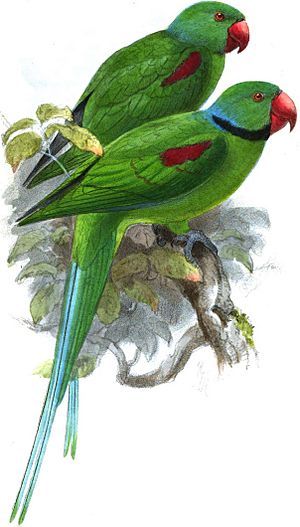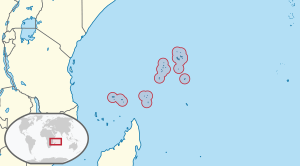Seychelles parakeet facts for kids
Quick facts for kids Seychelles parakeet |
|
|---|---|
 |
|
| Illustration of a male (front) and female, by John Gerrard Keulemans, 1876 | |
| Conservation status | |
| Scientific classification | |
| Genus: |
Psittacula
|
| Species: |
wardi
|
 |
|
| Location of the Seychelles | |
| Synonyms | |
|
|
The Seychelles parakeet (Psittacula wardi) was a type of bird that lived on the Seychelles islands. These islands are located in the Indian Ocean. Sadly, this beautiful bird is now extinct, meaning there are no more Seychelles parakeets left alive anywhere in the world. The last one was seen in 1883.
Contents
What Was the Seychelles Parakeet?
The Seychelles parakeet was a medium-sized parrot. It belonged to the Psittacula group, which includes many parakeets found in Asia and Africa. Scientists believe it was closely related to the Alexandrine parakeet, a larger parrot that is still alive today.
Appearance of the Bird
We don't have many detailed descriptions of the Seychelles parakeet. However, old drawings and a few notes from people who saw them help us imagine what they looked like. They likely had bright green feathers, which is common for many parakeet species. Males and females might have looked a bit different, perhaps in size or the color of their beaks.
Where Did They Live?
The Seychelles parakeet lived only on the Seychelles islands. These islands are a group of small islands in the Indian Ocean, off the coast of East Africa. The parakeets preferred areas with forests and plenty of trees, where they could find food and safe places to nest.
Why Did the Seychelles Parakeet Disappear?
The main reason the Seychelles parakeet became extinct was because of humans. As more people settled on the islands, the parakeets lost their homes.
Loss of Habitat
People started clearing forests to make space for farms and homes. This meant the parakeets had fewer trees to live in and fewer places to find food. Their natural environment was slowly destroyed.
Hunting and Trapping
Another big problem was that people hunted these birds. Sometimes they were hunted for food. Other times, they were trapped because farmers thought the parakeets were eating their crops, especially corn. Even though the birds were just trying to find food, this led to many of them being killed.
New Animals on the Islands
When people came to the islands, they often brought new animals with them, like cats and rats. These animals were not native to the Seychelles. They would hunt the parakeets or eat their eggs and chicks, making it even harder for the parakeet population to survive.
Lessons from Extinction
The story of the Seychelles parakeet teaches us an important lesson. It shows how human actions can have a big impact on wildlife. When we destroy habitats, hunt animals, or introduce new species, it can lead to the loss of unique creatures forever.
Protecting Other Species
Today, many people work hard to protect animals and their habitats. This includes creating national parks, stopping illegal hunting, and trying to control invasive species. The goal is to make sure that other animals don't suffer the same fate as the Seychelles parakeet.
Images for kids
-
Two male Alexandrine parakeets; this species is the closest living relative of the Seychelles parakeet
-
Only known depiction from life, showing a captive juvenile (left) and male, by Marianne North, 1883
See also
 In Spanish: Cotorra de las Seychelles para niños
In Spanish: Cotorra de las Seychelles para niños





